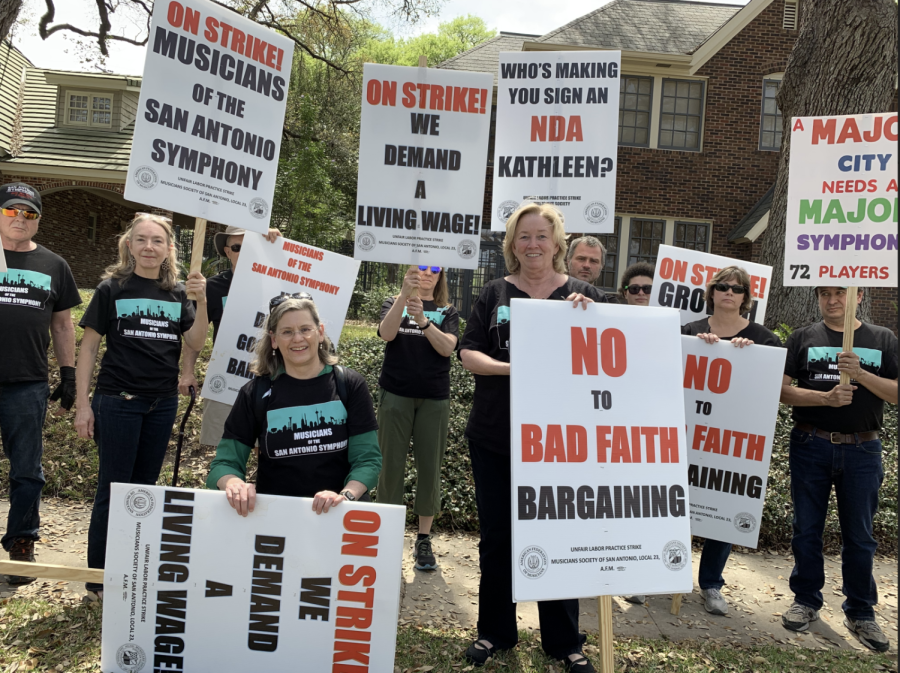UTSA faculty member and primary symphony violist Allyson Dawkins opens up about symphony’s mismanagement
Symphony members protest outside the home of Symphony Society Chair Kathleen Weir Vale. Photo courtesy of Diane Abdo
April 26, 2022
On Sept. 27, 2021, the San Antonio Symphony began its months-long strike after contract negotiations between the Symphony Society of San Antonio and the American Federation of Musicians reached a deadlock.
Allyson Dawkins, the principal violist for the symphony and associate professor of practice at UTSA, shared how financially unstable the orchestra has been since she joined. In fact, the Symphony declared bankruptcy in their 2003 to 2004 season.
“The entire 40 years I have been in the orchestra, it has been one financial emergency after the other,” Dawkins said. “One year we were bankrupt, one year we had numerous work stoppages. We had one other strike in around 1985; this is the first time we have been on strike since then.”
According to Dawkins, last summer, the management mentioned wanting to re-open the musician’s contract. This move was thought to be caused by the pandemic and the need to evaluate in its wake. However, once the contract was reopened, the Symphony Society of San Antonio was asked to cut around 20 players with a severe pay cut.
“A symphony orchestra has certain expected positions to be filled, and there is a proportionate number of violins, to violas, to cellos and then there is the woodwinds, harp, etc.,” Dawkins said. “It just made no sense at all. The pandemic didn’t necessitate that type of cut.”
“We want to remain at 72 players, but that’s low, we used to be at 84. They chipped away at it,” Dawkins added. “Symphony contracts are usually three years, but after that, you go back to the bargaining table depending on what’s going on with the economy and the city.”
Dawkins explained how the orchestra slowly began losing players.
“When these negotiations come up, sometimes there will be two violinists who will resign and they will say ‘we don’t plan to replace them,’” Dawkins said. “We are on the small side; we only have seven violas; seven violas don’t make a lot of sounds.”
The Symphony Society has a CEO who answers to the board of trustees. According to Dawkins, the CEO is hired, but the board of trustees is self-perpetuating.
“They tend to be influential people in the community that supposedly have a passion for music. The concept is wealthy people have wealthy friends and they can ask their friends to support the orchestra,” Dawkins said.
The Society made a “Last, Best and Final” offer in September, which the union rejected. Their offer included the cut of full-time symphony musicians from 72 to 42, as Dawkins mentioned. It would reduce the season from 31 to 26 weeks, hire some part-time musicians with an $11,000 salary and cut the salaries of full-time musicians from $36,000 a year to $24,000.
To add to the tension, the San Antonio Symphony ended its contact with Music Director Emeritus Sebastian Lang-Lessing this month. The board said the decision to terminate Lang-Lessing’s contract was based on a violation of their contract.
“The symphony management fired our Music Director Emeritus, that is [an] honorary title,” Dawkins said. “To fire that person, to me, it’s like firing the pope, you don’t do that. They were put there in a place of honor. They fired him because they are conducting us in two weeks, it was purely retaliatory. There have been four or five articles in the news and it’s just giving our performance more publicity.”
Dawkins mentioned why making a liveable wage is important, not only for personal expenses, but also for materials necessary to the symphony’s trade.
“We were making slightly over $30,000. I have a Master’s degree. I won my job in the orchestra behind a screen anonymously, that’s standard. Most of us have at least a Master’s, some have a Doctorate’s degree,” Dawkins said. “Not only that, some have trained when we were in high school, or even earlier. They are highly-trained individuals. We are also kind of like medical professionals because we have so much special training and it’s so expensive. There is a lot of pressure to have a high-quality instrument. It takes a lot of money to keep it in playing condition. My best bow cost me $15,000.”
The symphony is a nonprofit that gains funding in three ways: earned revenue from ticket sales or performances; contributed revenues, which includes donations, grants, and public funding; and endowment funds. In the 2018 to 2019 season, the symphony generated $5 million in revenue and $8 million in expenses.
Dawkins mentioned that the $5 million budget is not enough, considering the symphony is classified as a major orchestra. In addition, the San Antonio Symphony’s budget is nowhere near the budgets of other cities in Texas. The Houston Symphony is in the process of growing its fund from $70 million to $100 million.
Dawkins speculates the reason the Symphony is not compromising when it comes to the union’s negotiations is because of the Tobin Center for the Performing Arts and union-busting.
“In the state of Texas, unions are frowned upon. A lot of people don’t understand a musicians union is a professional union. We are protecting our rights for a living wage. You know how opinionated people get about politics? A lot of people are like that with unions,” Dawkins said. “It’s also partly the Tobin [Center for the Performing Arts]. It was built for the symphony with taxpayers’ money when it opened up five years ago. When we got in there, they realized we took up the whole week and they couldn’t do their one-night stand performance. The Tobin really wants to limit the amount of time the symphony spends inside.”
According to Dawkins, the strikers have received immense support from the community.
“It’s been incredible. We have already done one concert in March, it was full to the brim both nights. There are so many people in [San Antonio] who want to come and hear the symphony. We are expecting the same thing later on,” Dawkins said.
Despite the show of solidarity from the public, Dawkins still said she was concerned for her students and vice versa.
“I am very concerned for the future of my students. They are all taking this very hard, seeing what their teachers are going through. There are five music teachers who are in the symphony. They are concerned about their own future. We have a really high success rate of turning out top-notch middle and high school music teachers,” Dawkins said. “They look to the symphony for inspiration and are able to tell their students they studied with a symphony player and that is how they inspire their students. They just don’t understand seeing their respected teacher being disrespected and it’s very painful for them and I’m concerned about it.”












